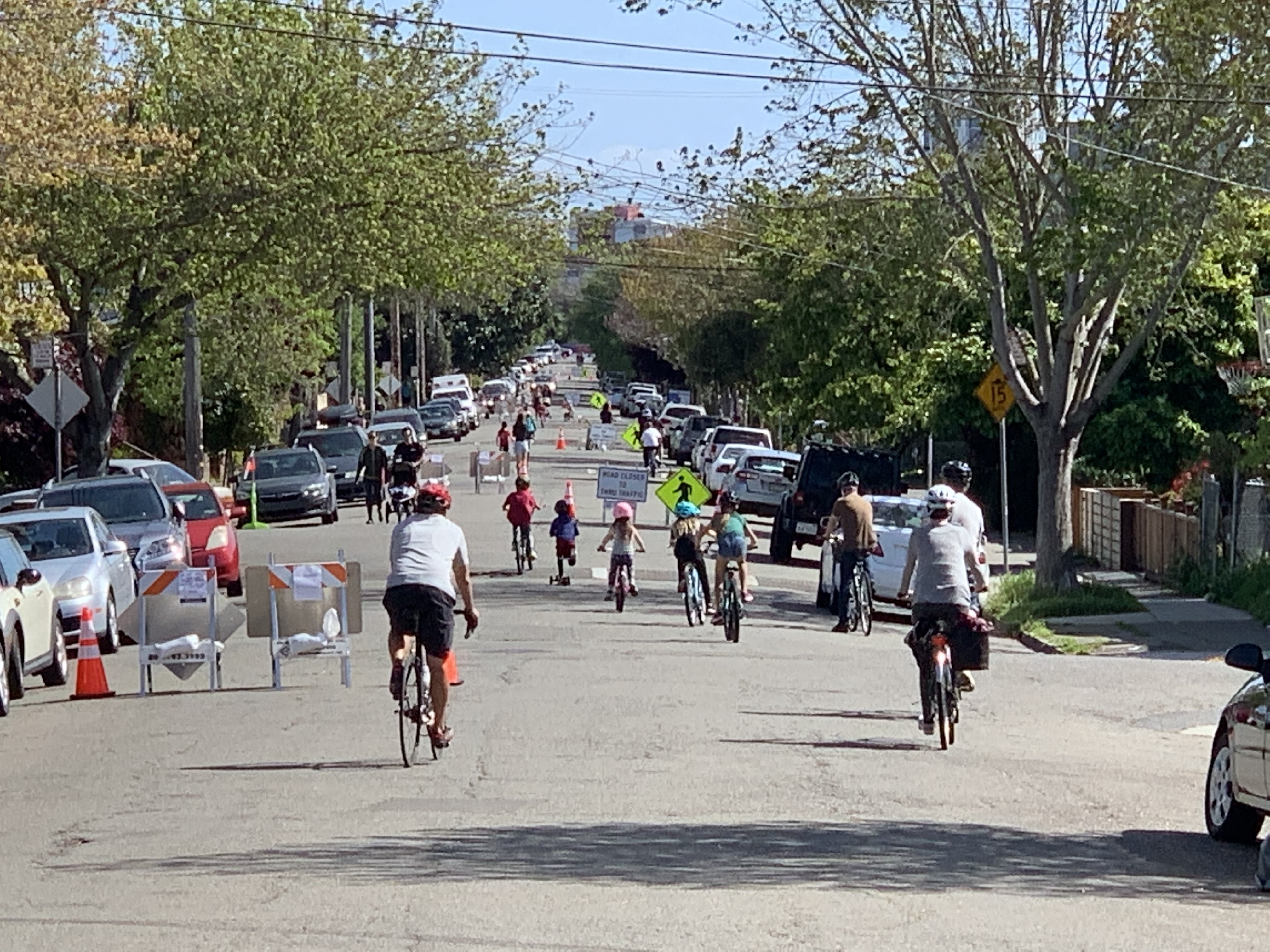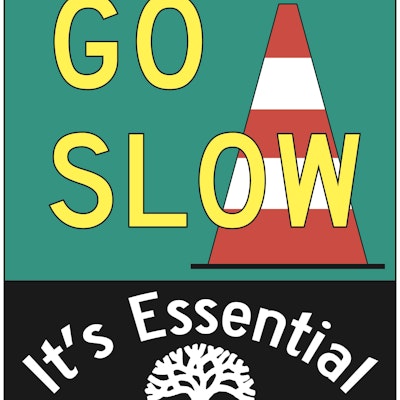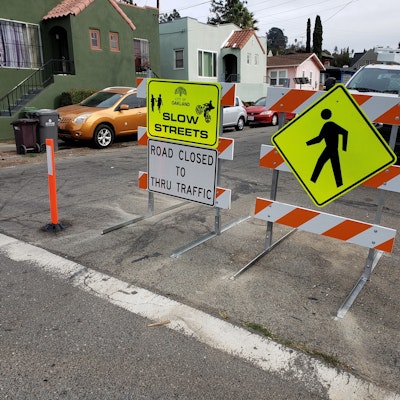This web page is an archive of Oakland’s Slow Streets – Essential Places Program during the first two years of the Covid-19 pandemic. It began in April to July 2020 when Oakland’s Department of Transportation (OakDOT) closed 21 miles of streets to create neighborhood space for physical and social activity during shelter-in-place. It concluded with the reopening of those streets by February 2022. See this page for OakDOT’s ongoing work on Slow Streets based on lessons learned during the pandemic.
Overview
At the outset of the Covid-19 pandemic from April to July 2020, OakDOT closed 21 miles of neighborhood streets for outdoor physical activity and made pedestrian safety improvements at 15 essential services – health clinics, food distribution hubs, testing sites, and grocery stores. This period is described below as Phase 1. This was followed by Phase 2, a period of evaluation, adjustment, and growing awareness that the pandemic was becoming a multi-year event. In early 2022 OakDOT shifted to Phase 3, removing temporary materials and the street closures in response to the reopening of the economy, the end of shelter-in-place, and an acknowledgement that there would not be a well-defined “end” to the pandemic.
Phase 1 – Implementation of the Pandemic Response
The Slow Streets Program was rolled out over a period of three months in April to July 2020. “Soft closure” barriers were installed on 21 miles of streets throughout the city in support physical activity with social distancing.
Another component of the program, Essential Places, was rolled out from May to July 2020. This work installed temporary pedestrian safety improvements at 15 locations to support residents’ safe access to essential services including grocery stores, food distribution sites, and Covid-19 test sites. Improvements included safety islands, lane closures at uncontrolled crosswalks, automatic walk phases at traffic signals, and signage to raise awareness of pedestrian safety at essential services (“Go Slow – It’s Essential”).
In the summer and early fall of 2020, OakDOT partnered with local artist Jonathan Brumfield to experiment with the design of street closure barricades and signage. The goal of the experimentation was to imagine design solutions that were aesthetic, durable, and culturally relevant to East Oakland neighborhoods. It was motivated by early indications that Slow Streets were being used less by people of color in Oakland’s working class neighborhoods. The partnership with Jonathan Brumfield was made possible by a grant from Smart Growth America. The project is described in detail in Mae Hanzlik’s article “Redesigning Slow Streets to reflect community & culture in East Oakland.”
Phase 1 concluded in September 2020 with the publication of the “Oakland Slow Streets Interim Findings Report”. The report summarized the program to date and analyzed traffic counts, intercept surveys, social media posts, and numerous online surveys. Notably, the report found that the use of Slow Streets – and participation in Slow Streets outreach – varied significantly by race, class, and geography.
Phase 1 Documentation
- Map of locations (pdf | interactive map)
- Interim Findings Report (September 2020)
- Press Releases (April to September 2020)
Phase 2 – Adaptation to Sustain the Program
Beginning in October 2020, OakDOT made location-specific changes in recognition that Slow Streets corridors were not working the same in every neighborhood. More adjustments were made in response to increased traffic in summer 2021 with the California reopening and children returning to school. Simultaneously, the use of Slow Streets decreased with the end of shelter-in-place and with the reopening of parks, schools, and commercial establishments. The two main themes of Phase 2 were adapting to the changing nature of the pandemic; and pursuing more durable materials to reduce the staff time required to keep temporary materials in place.
One corridor was evaluated and modified based on feedback from the neighborhood group that OakDOT had partnered with to implement the Slow Street. For other corridors, surveys were sent to every address to solicit feedback on those specific corridors. The resulting modifications included Slow Streets signage and barricades being upgraded to more durable materials and the installation of additional treatments at major cross-streets. OakDOT removed some Slow Streets barricades at specific school locations in response to requests from those schools and to allow for AC Transit to resume its school bus routes.
Slow Streets with Corridor-wide Modifications
- Ney Ave (73rd Ave to 82nd Ave)
- November 2020: The Ney Ave Slow Street was installed in partnership with the local neighborhood council to address issues of traffic and interpersonal violence. As a result of ongoing communications with the neighborhood council, the Slow Street on Ney Ave was upgraded to more durable barricades with Slow Street specific signage and flex posts mounted into the street.
- Brookdale Ave (Fruitvale Ave to Kingsland Ave)
- December 2020: Survey sent to residents with results available here.
- February 2021: As a result of the feedback, OakDOT installed more durable barricades with Slow Street specific signage and flex posts mounted into the street along the Brookdale Ave Slow Street Corridor and made adjustments to reduce conflicts at major cross streets like Fruitvale Ave, 35th Ave, and High St by moving the barricades back from the major street and adding signage on the major streets approaching the Slow Street.
Additional Slow Streets Corridors with Survey Results
- Arthur St / Plymouth St (Havenscourt Blvd to 104th Ave)
- December 2020: Survey sent to residents with results available here. The Arthur St/Plymouth St Slow Street was supported by 58% of respondents and remained in place without modification
- 16th St (Wood St to West St)
- March 2021: Survey sent to residents with results available here. The 16th St Slow Street was supported by 65% of respondents and remained in place without modification.
- 32nd St (Mandela Pkwy to San Pablo Ave)
- March 2021: Survey sent to residents with results available here. The 32nd St Slow Street was supported by 60% of respondents and remained in place without modification
- E 16th St (23rd Ave to Fruitvale Ave)
- March 2021: Survey sent to residents with results available here. The E 16th St Slow Street was supported by 55% of respondents and remained in place without modification.
Essential Places Upgrades to More Durable Materials
- Bancroft Ave at Avenal Ave: concrete pedestrian safety island allowing pedestrians to cross one direction of Bancroft Ave at a time; located at a supermarket
- Fruitvale Ave between International Blvd and Foothill Blvd: road diet reducing the number of travel lanes pedestrians must negotiate in crossing Fruitvale Ave; located at multiple health clinics and markets
- 14th St and Market St: bulbouts to widen sidewalks and shorten crossing distances; located at a school
- Adeline St at 18th St: hardened centerlines reducing the speed of turning drivers to support pedestrians crossing both Adeline St and 18th St; located at a branch library and a senior center
- 18th St west of Adeline St: hardened centerlines at a mid-block school crosswalk to calm traffic; located at a park and a school
Phase 3 – Conclusion of the Pandemic Response
In January-February 2022, OakDOT removed all temporary Slow Streets and Essential Places materials, including temporary street closures. This change was prompted by the ongoing nature of the pandemic, the continuing reopening of the economy, and the practical challenges of using temporary materials on a long-term basis. The removal of the temporary materials allowed OakDOT staff to return to their pre-pandemic responsibilities and to consider how lessons learned from the pandemic could inform permanent programs.
Public reaction was strong and mixed. Bicyclist and pedestrian advocates lamented the loss of these streets as active transportation corridors. Residents along the Slow Streets complained about the return of cut-through traffic and higher speeds. People were frustrated by no longer being able to use the streets to socialize with neighbors and let kids play. Other residents welcomed the removal of the barricades that had made it difficult for them to get into and out of their neighborhoods. Residents on nearby parallel streets welcomed the end of traffic being diverted to their streets.
What lessons for city streets did OakDOT staff learn from the upheaval of Covid-19? People want comfortable and safe public places to walk, bike, jog, and socialize. In lower income communities of color, issues like housing, work, childcare, and public safety were more pressing than using street space to recreate. People broadly care about traffic safety. Motor vehicle use on many streets effectively excludes most other uses from those streets. No one likes cut-through traffic or speeding on their street. In the early and dark months of the pandemic, Slow Streets did bring joy to many people, families, and neighborhoods.
In ending the Slow Streets – Essential Places Program as a pandemic response, OakDOT identified three promising areas for ongoing work:
- Essential Places: Prioritize pedestrian safety improvements at essential services that our residents, particularly the most vulnerable, rely on. Use quick build and permanent construction methods to implement meaningful, timely, and sustainable safety improvements.
- Slow Streets: Implement permanent Slow Streets through the City’s planning-to-date for Neighborhood Bike Routes (also known as bike boulevards) and the construction opportunities offered by the Five Year Paving Plan and Capital Improvement Program. Develop a network of Slow Streets that serves pedestrians, bicyclists, and micro-mobility users, and advances these streets as community space. Proactively address nearby residents’ concerns for diverted traffic through planning, outreach, and context-sensitive design.
- Pop-Up Slow Streets: Support neighbors’ use of streets as community space by advancing opportunities for temporary street closures initiated and produced by residents. OakDOT envisions "Pop-Up Slow Streets" as block parties that encourage culture change for using neighborhood streets as community space.
Documents for Phase 3
Last updated: 2/3/2023


